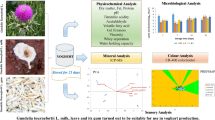Abstract
Both amaranth and bean flours were higher in protein, minerals and vitamins than whole wheat flour along with gluten-free benefits. Nutritious gluten-free breads were developed using amaranth flour combined with 15% or 30% soybean, lupin, or navy bean flour, respectively. Amaranth and bean flours exhibited higher water holding capacity than whole wheat flour. The pasting property of amaranth flour was lower than that of whole wheat flour but higher than bean flours. All blends revealed shear thinning properties that are important for mouthfeel and industrial applications. Volumes of breads using amaranth-soy 85:15 and 70:30 and amaranth-lupin 85:15 were larger than amaranth bread, and had less reductions compared to whole wheat bread. The amaranth bread and breads substituted with soybean, lupin and navy bean flours showed significantly higher or similar springiness compared to the whole wheat flour breads because of their high proteins and water holding capacity. The firmness of bread using amaranth-soy 85:15 and 70:30, and amaranth-lupin 85:15 was improved by amaranth, which was very close to whole wheat bread. Amaranth breads with bean flours added high-value plant protein and nutrients in foods along with enhancing health benefits compared to the gluten-free bread using starches currently on market.





Similar content being viewed by others
References
E. Gallagher, T.R. Gormley, E.K. Arendt, Trends Food Sci. Technol. 15, 143–152 (2004). https://doi.org/10.1016/j.tifs.2003.09.012
USDA National Nutrient Database. (2018). http://ndb.nal.usda.gov/ndb/foods/show/6238. Assessed 30 May 2018
L.R. Myers, H.D. Putnam, Growing grain amaranth as a specialty crop. In: Crop systems. University of Minnesota. FS-03458-GO. (1988)
D.M. Martirosyan, L.A. Miroshnichenko, S.N. Kulakova, A.V. Pogojeva, V.I. Zoloedov, Lipids Health Dis. 6, 1 (2007). https://doi.org/10.1186/1476-511X-6-1
C.L. Handa, U.R. Couto, A.H. Vicensoti, S.R. Georgetti, E.I. Ida, Food Chem. 152, 56–65 (2014)
E.G. De Mejia, T. Bradford, C. Hasler, Nutr. Rev. 61, 239–246 (2003)
I.S. Dalaram, Potravinarstvo Slovak J. Food Sci. 11, 26–34 (2017)
R. McPherson, Dietary fiber―A perspective. In: Dietary fiber in human nutrition, CRC handbook, 2nd edn., ed. by G.A. Spiller (CRC Press, Boca Raton, FL, 1992), pp. 7–11 ed by
V. Ha, J.L. Sievenpiper, R.J. de Souza, V.H. Jayalath, A. Mirrahimi, A. Agarwal, L. Chiavaroli, S. Blanco Mejia, F.M. Sacks, M. Di Buono, A.M. Bernstein, L.A. Leiter, P.M. Kris-Etherton, V. Vuksan, R.P. Bazinet, R. Josse, J. Beyene, C.W. Kendall, D.J. Jenkins, Can. Med. Assoc. J. 186, E252–E262 (2014)
Consultative Group for International Agricultural Research. Improving Nutrition and Health (2018) http://grainlegumes.cgiar.org/why-grain-legumes-matter/improving-nutrition-and-health/. Accessed 15 June 2018
J.A. Ayo, Int. J. Food Prop. 4, 341–351 (2001). https://doi.org/10.1081/JFP-100105198
P.A. Akin, R.A. Miller, Cereal Chem. 94, 897–902 (2017)
B.I.O. Ade-Omowaye, K.A. Taiwo, N.M. Eshtiaghi, A. Angersbac, D. Knorr, Innov. Food Sci. Emerg. Technol. 4, 177–188 (2003). https://doi.org/10.1016/S1466-8564(03)00020-1
A.A.C.C. International, Approved methods of analysis (Methods 32-23.01, 32-25.01, and 44-15.02), 11th edn (AACC International, St. Paul, 2010)
SAS Institute INC, The SAS ® system for Windows ®, version 8e (SAS, Cary, 1999)
University of Maryland Medical Center. K. Vitamin (2017) http://umm.edu/health/medical/altmed/supplement/vitamin-k#ixzz33t70aIeT. Accessed 05 Apr 2017
S. Qiu, M.P. Yadav, L. Yin, Food Chem. 230, 225–233 (2017)
H.M. Lai, H.-H. Cheng, Int. J. Food Sci. Technol. 39, 201–212 (2004)
I.L. Batey, Interpretation of RVA curves. Chapter 2. In: RVA hand book, ed. by G.B. Crosbie, A.S. Ross (AACC international, St Paul, 2007)
Newport Scientific Pty. Ltd. The application manual for the rapid visco analyser (Newport Scientific Pty. Ltd, Warrriewood, 1998)
S. Ragaee, E.-S.M. Abdel-Aal, Food Chem. 95, 9–18 (2006)
I.L. Batey, B.M. Curtin, Cereal Chem. 77, 754–760 (2000)
H.A. Fonseca-Florido, C.A. Gómez-Aldapa, G. López-Echevarría, G. Velazquez, E. Morales-Sánchez, J. Castro-Rosas, G. Méndez-Montealvo, LWT Food Sci. Technol. 87, 280–286 (2018)
H. Corke, Specialty Cereal and Noncereal Starches. Chapter 4. In: The RVA Handbook, ed. by G.B. By, Crosbie, A.S. Ross (AACC International, St. Paul, 2007), p. 55
N.G. Gravier, N.E. Zaritzky, A.N. Califano, J. Food Sci. 9, 123–128 (2004). https://doi.org/10.1111/j.1365-2621.2004.tb13364.x
J.C. Salamone, Polymeric materials encyclopedia (CRC Press, St. Paul, 1996)
A.S. Szczesniak, E. Farkas, J. Food Sci. 27, 381–385 (1962). https://doi.org/10.1111/j.1365-2621.1962.tb00112.x
V. Giannone, M. Giarnetti, A. Spina, A. Todaro, B. Pecorino, C. Summo, F. Caponio, V.M. Paradiso, A. Pasqualone, Food Chem. 241, 242–249 (2018)
Author information
Authors and Affiliations
Corresponding author
Additional information
Publisher’s Note
Springer Nature remains neutral with regard to jurisdictional claims in published maps and institutional affiliations.
Disclaimer
Mention of trade names or commercial products in this article is solely for the purpose of providing specific information and does not imply recommendation or endorsement by the US Department of Agriculture. USDA is an equal opportunity provider and employer.
Rights and permissions
About this article
Cite this article
Liu, S., Chen, D. & Xu, J. Characterization of amaranth and bean flour blends and the impact on quality of gluten-free breads. Food Measure 13, 1440–1450 (2019). https://doi.org/10.1007/s11694-019-00060-4
Received:
Accepted:
Published:
Issue Date:
DOI: https://doi.org/10.1007/s11694-019-00060-4




